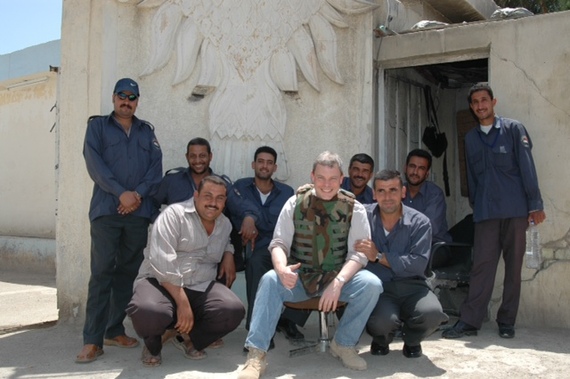This week, Dr. Jerry Umanos, a Chicago pediatrician who moved to Afghanistan to treat children and train Afghan physicians was gunned down at a Kabul hospital -- killed by an Afghan police guard. While we have become sickeningly accustomed to hearing about "green on blue" attacks on our soldiers as the Afghan people become more and more disenchanted with foreign troops operating on their soil -- this was a cold blooded attack on a civilian non-military worker.
A fact that is often overlooked these days, is that our wars are fought not only with soldiers, but with a great number of civilian workers going out alongside of them -- military contractors who perform a myriad of tasks supporting military operations; government agency workers representing in the case of the U.S. -- the Departments of State, Energy, Labor, Health & Human Services, etc.; journalists; and nongovernmental (NGO) workers performing all kinds of missions -- many of them humanitarian.
Most people don't realize that in 2007 there were actually more civilian contractors in Iraq than combat troops and that in 2009 contractor deaths exceeded military deaths in Iraq. According to a 2013 report of the Special Inspector General for Iraq Reconstruction (SIGIR): "In September 2007, the United States had more than 170,000 combat personnel in Iraq as part of the counterinsurgency operation, with more than 171,000 contractors supporting the mission.'' These contractors are credited in the report for supporting "the counterinsurgency mission in unstable, yet strategically significant, areas such as Baghdad, Anbar, and Babylon provinces."
And when contractors, NGO workers and civilians serve in high threat security zones they are often not working with the same pre-deployment training or the same support during and after their deployments that military and government workers receive. Yet they too get injured and killed -- like Dr. Umanos -- who was trying to train up an Afghan medical force. And even when they return home safely -- mission completed -- they, and their families can still suffer considerable psychological strain in the months and even years to come. But there is no Veterans Health Administration for civilian workers to turn to for support. And sadly we as a society are still slow to recognize our hundreds of thousands of civilians who have or are now serving abroad in high threat and danger zones.
The dangers for civilians are greater now that the military outsources many of its jobs to civilian contractors just as the dynamics of war have also drastically changed. These days, with guerilla and terrorist adversaries attacking anywhere at anytime, the battlefront "rear" and "front" no longer are clearly delineated. The enemy attacks any and everywhere, placing civilians who assist military operations in the same dangers as the uniformed warriors and often injuring and killing civilian workers who would have in the past been operating in the "rear".
While our military serviceman returning from Iraq and Afghanistan have faced shameful delays and nonresponsive replies from the Veterans Health Administration to get their claims covered -- civilian contractors who return from the battle space with similar injuries -- including limbs blown off, traumatic brain injury, PTSD, depression, traumatic bereavement and the like -- have found they too have had to battle with the insurance coverage provided under the Defense Base Act (DBA) -- a law requiring insurance coverage for those contracting with any agency of the U.S. government for work outside the U.S.
At present the recording of civilian contractor deaths in conflict zones is thought by many to be underreported and sadly many of these civilians die unheralded. Likewise those who are wounded are finding it difficult to get their needs met.
In terms of psychological well being, a 2013 RAND study, aptly titled "Out of the Shadows: The Health and Well-Being of Private Contractors Working in Conflict Zones" found evidence for posttraumatic stress disorder (PTSD) in twenty-five percent of their sample, depression in eighteen percent, and alcohol misuse in over half the sample. And longer deployments and increased combat exposure was associated with higher rates of distress. In our 2007 study of resilience in civilians deployed in Iraq, our research team found similar findings.
Serving in a combat zone, high threat or danger zone is just that -- dangerous -- and it's time we recognized the hundreds of thousands of civilians who are doing just that. A new organization We Served Too (WS2) has been formed with the mission to raise awareness; conduct research; develop education materials; support resilience, health and well-being; and create a web-based community, support network and information resource for those who are serving or have served in conflict and high threat security zones. Currently an oral history project collecting lessons learned from civilians who deployed into conflict and high threat/danger zones is underway. Volunteers and civilians who served are welcome to join.
Today colleagues of Jerry Umanos told CNN that Jerry "loved the Afghan people, loved the country, and loved to teach". We need to honor his service and ultimate sacrifice just as we do for our military soldiers, and support all those, like him, who are risking it all to try to make our world a better place.
Anne Speckhard, Ph.D. is Adjunct Associate Professor of Psychiatry at Georgetown University in the Medical School and author of Talking to Terrorists. She conducted psychological autopsies of over half of the Chechen suicide terrorists, interviewed hostages from Beslan and Nord Ost and has interviewed over four hundred terrorists, their family members and supporters in various parts of the world. She is Co-Director, with Martha Hudson, at We Served Too.


